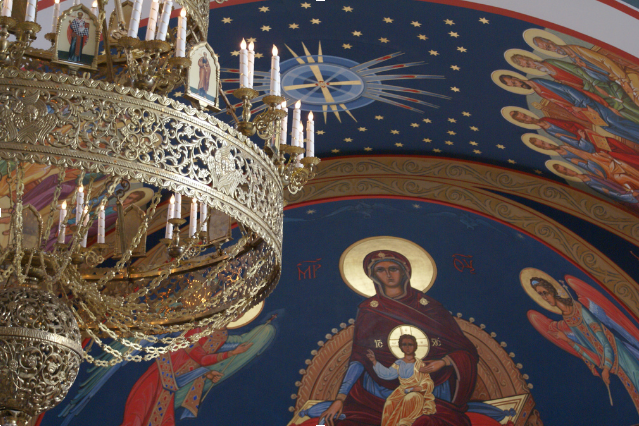
Iconography in the Apse of Holy Theophany Church in Colorado Springs.
We are beginning to wrap up our ongoing discussion of how the Church views the Ark of the Covenant. We have covered many concrete examples and are now embarking on some analysis of what we have learned.
We have traced how the people of God have understood the ark from its very beginning to its contemporary expression within the Church. We have examined how the Ark was built and we followed its life in Israel up until its disappearance. Subsequently, we examined possible midrashic traditions latent in Scripture that typologically identify the Ark with the Holy Virgin. We examined so-called apocryphal literature that provides useful clues. We traced the great conversation of the Holy Fathers on this topic through the first seven centuries. And finally, we examined the expression of the Ark’s typology in the life of the Church: its iconography, services, and hymnology.
In this particular case study, and perhaps others, we find a distinct pattern. First, the subject of typological interest comes into existence. In our case, the Ark is explicitly “spec’d out” by God himself and is then constructed under the guidance of the Prophet Moses. The Ark gains a certain mystique throughout its developing life among the people of Israel, becoming a key emblem or meme in the mythos of the nation of Israel. Whether we are talking about a physical artifact such as the Ark or a story such as Abraham’s hospitality to his three visitors (a topic for an upcoming series of posts), the type follows this same path.
The next step is the Gospel. Saint Paul alludes to the application of forward looking typology to the Old Testament, saying, “For the law having a shadow of good things to come, and not the very image of the things, can never with those sacrifices which they offered year by year continually make the comers thereunto perfect” (Hebrews 10:1). In our specific case, it is affirmed by Saint John Damascene as noted earlier. The Gospel becomes the lens that we use to interpret the ancient types, but the interpretation does not necessarily become clear immediately, as in our case.
Clearly, given the fact that accounts of the Gospel and other contemporaneous events were recorded significantly later, either an oral tradition or long lost documents carry the stories forward in time until they are written down. Interpretations may grow organically within this mix, as hypothesized by Laurentin and others, influencing the recording of Scripture and other writings.
We begin to truly see the application of typology surface in the writings of the Holy Fathers, where it develops through the centuries. As the present author might observe from a similar study of the typology attached to the story of the Hospitality of Abraham, a turning point in the application of the typology seems to sometimes occur during the third or fourth centuries. It is probably not coincidental that this was a time of great upheaval and development within the church, owing to the occurrence of many heresies and the refining of doctrinal articulation that was carried out by the great ecumenical councils. In our case we see a transition from a clearly Christocentric typology of the Ark to its identification with the Holy Virgin Mary (the shift seems to happen somewhere between Saint Dionysius and Saint Athanasius). While both typological traditions may have coexisted from very early times, the Church shifted emphasis from one to the other as its understanding deepened.
The title Theotokos is not truly rooted in Mariology, but in Christology. It does honor to the Theotokos by recognizing her role in the incarnation, but she is called the God Bearer not due to her own nature, but because of the nature of her son. The ecumenical councils sought to clarify the nature of Jesus Christ and this clarification shone light also upon the role of Mary, which may have influenced how the Church viewed the typology of Mary and of the Ark.
After the conciliar age, the typology seems to stabilize and we see it becoming part of Orthodox praxis in the services of the Church as described above. Iconography finally incorporates the typology and we not only hear it in the hymnology, but see it on the walls of the church. In the end, lex orandi, lex credendi: the law of praying is the law of believing.
Here we have discussed the implications of theological/typological development within the church. In our next post in this series, we will discussion the implications of the fully developed typology.